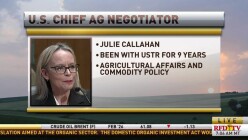South America
China’s pullback is hitting core U.S. commodities hard, reshaping export expectations for soybeans, cotton, grains, and livestock.
While this month’s WASDE report will not include updated figures on U.S. crop size, officials say it will offer a clearer picture of crop conditions in the Southern Hemisphere.
Tyson’s Nebraska plant closure and falling Cattle on Feed numbers send cattle markets tumbling. Analysts warn of tighter supplies, weak margins, and rising global competition.
One trader said the products entering the U.S. are primarily grind and trim, noting that the volume and type of beef, on its own, should not cause a major disruption. However, he says fund traders are reacting heavily to headlines rather than market realities.
Removing the 40% duty sharply lowers U.S. beef import costs on beef, coffee, fertilizer and fruit, and restores Brazil’s competitiveness during a period of tight domestic supply.
Heavy rains are wreaking havoc on Argentina’s farmland, leaving nearly 4 million acres at risk and delaying corn and soybean plantings in one of the world’s top grain export regions.
Dalton Henry, with U.S. Wheat Associates, joined RFD-TV to provide insight on what the pending trade frameworks may mean for American wheat growers.
U.S. Trade officials announced new deals with El Salvador, Guatemala, Ecuador, and Argentina, as well as a steep reduction in tariffs on Swiss imports.
China’s cost advantage with Brazilian soybeans and vague public messaging leave U.S. export prospects uncertain heading into winter.
Lucia Ruano, USMEF’s Central America representative, discusses what is driving demand for U.S. beef and pork in the region.
Stagger buys and diversifies fertilizer sources — watch CBAM, India’s tenders, and Brazil’s import pace to time urea, phosphate, and potash purchases.
Pork producers should prioritize health and productivity gains, hedge feed and hogs selectively, and watch Brazil’s export pace and China’s sow policy for price signals.
U.S. sugar producers and processors should brace for price pressure and challenging export logistics with global sugar supply ramping up — driven by Brazil, India, and Thailand — especially at the raw processing level.
An import lag for ground beef will likely look different than last year’s egg shortage. The difference comes down to biosecurity and market flexibility.
China’s crusher losses and Brazil tensions, Gale warns, could reopen critical soybean trade channels for U.S. producers.
China’s grain expansion model may be hitting its limit. Lower prices, high rents, and policy fatigue threaten future output — with ripple effects across global feed and oilseed markets.
Market analyst and friend of the show, Shawn Hackett, says Brazil’s shifting use of crops for biofuel production is a significant factor.
Rich Nelson, a commodity broker for Allendale Inc., joins us to break down what the U.S.-China trade agreement means for the ag economy.
Cattle markets are collapsing this week, and analysts say that several factors are at play. Consumer beef prices also remain near all-time highs, threatening long-term demand.
The idea of buying more beef from Argentina does not sit well with much of farm country, raising some questions from analysts and producers.
Imported lean beef continues to play a critical role in U.S. hamburger and ground-beef production, with any added volume from Argentina serving as a supplement — not a market overhaul.
A fast-moving series of trade signals from the White House and key partners is resetting the near-term outlook for U.S. agriculture.























